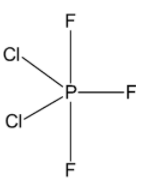
In
A.Axial position
B.Equatorial position
C.Axial as well as equatorial position
D.Cannot be predicted
Answer
455.4k+ views
1 likes
Hint: To answer this question you must recall the concept of hybridization. Hybridization is the concept of mixing of atomic orbitals resulting into the formation of new hybrid orbitals that possess different shapes and energies as compared to the original parent atomic orbitals.
Complete step-by-step answer:We know that in
Since the equatorial bonds have a higher
We know that fluorine is more electronegative than chlorine and thus two fluorine atoms occupy the axial positions while the third fluorine atom occupies an equatorial position alongside two chlorine atoms.

Thus, the correct answer is C.
Note: The Valence shell electron pair repulsion theory (VSEPR Theory) proposes that the hybridized orbitals in an atom arrange themselves in such a way so as to minimize the repulsion between them, hence specifying the geometry of a molecule on the basis of its hybridization. Hybrid orbitals are suitable for the formation of chemical bonds having equal energies. Also, since hybrid orbitals have lower energy than the unhybrid orbitals, hybridization of orbitals leads to the formation of more stable compounds.
Complete step-by-step answer:We know that in
Since the equatorial bonds have a higher
We know that fluorine is more electronegative than chlorine and thus two fluorine atoms occupy the axial positions while the third fluorine atom occupies an equatorial position alongside two chlorine atoms.

Thus, the correct answer is C.
Note: The Valence shell electron pair repulsion theory (VSEPR Theory) proposes that the hybridized orbitals in an atom arrange themselves in such a way so as to minimize the repulsion between them, hence specifying the geometry of a molecule on the basis of its hybridization. Hybrid orbitals are suitable for the formation of chemical bonds having equal energies. Also, since hybrid orbitals have lower energy than the unhybrid orbitals, hybridization of orbitals leads to the formation of more stable compounds.
Latest Vedantu courses for you
Grade 11 Science PCM | CBSE | SCHOOL | English
CBSE (2025-26)
School Full course for CBSE students
₹41,848 per year
EMI starts from ₹3,487.34 per month
Recently Updated Pages
Master Class 11 Economics: Engaging Questions & Answers for Success

Master Class 11 Business Studies: Engaging Questions & Answers for Success

Master Class 11 Accountancy: Engaging Questions & Answers for Success

Master Class 11 English: Engaging Questions & Answers for Success

Master Class 11 Computer Science: Engaging Questions & Answers for Success

Master Class 11 Maths: Engaging Questions & Answers for Success

Trending doubts
State and prove Bernoullis theorem class 11 physics CBSE

1 ton equals to A 100 kg B 1000 kg C 10 kg D 10000 class 11 physics CBSE

State the laws of reflection of light

One Metric ton is equal to kg A 10000 B 1000 C 100 class 11 physics CBSE

1 Quintal is equal to a 110 kg b 10 kg c 100kg d 1000 class 11 physics CBSE

Difference Between Prokaryotic Cells and Eukaryotic Cells




